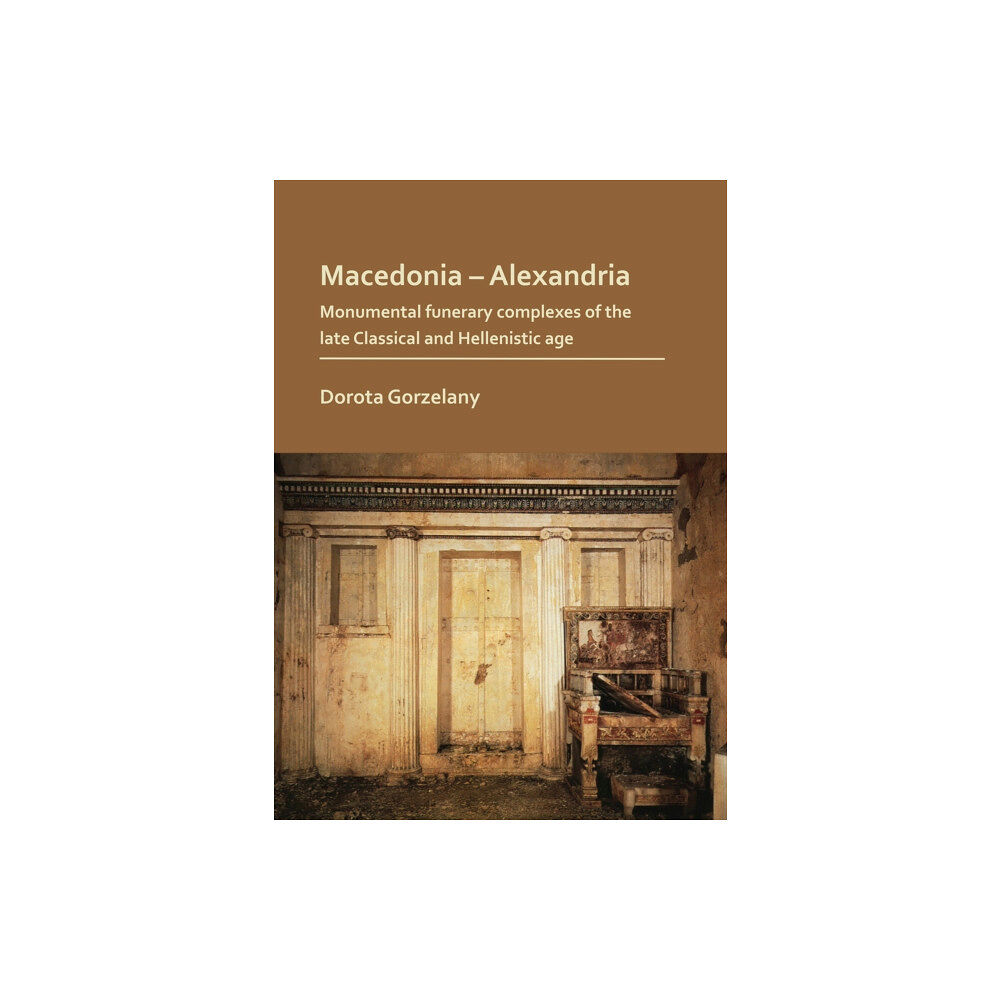- Hem
- Böcker
- Kurslitteratur
- Historia
- Macedonia - Alexandria: Monumental Funerary Complexes of the Late Classical and Hellenistic Age (häftad, eng)

Macedonia - Alexandria: Monumental Funerary Complexes of the Late Classical and Hellenistic Age (häftad, eng)
The type of monumental tomb that developed in Macedonia in the late Classical period was undoubtedly the most impressive of all the Greek fu...
479 kr
525 kr
Bara 2 kvar
Skickas inom 2-3 vardagar
- Fri frakt
Fri frakt över 299:-
Snabb leverans
Alltid låga priser
Produktbeskrivning
The type of monumental tomb that developed in Macedonia in the late Classical period was undoubtedly the most impressive of all the Greek funerary complexes. It was a burial chamber with a vestibule, built of stone blocks, vaulted and furnished with an architectural facade, concealed under a large tumulus rising above the ground.
The concept of the Macedonian sepulcher, which the Macedonians and Greeks settling in Alexandria ad Aegyptum, the city founded by Alexander the Great on the Egyptian coast, brought with them, influenced the structural form of the underground tombs that were developed in the new city.
‘Macedonia–Alexandria’ explores the scope of this influence, comparing in synthetic form the structural elements of the cist graves, chamber and rock-cut tombs of Macedonia with the Alexandrian hypogea, while taking into account the different geographical factors that conditioned them.
This is followed by a presentation of the facade and interior decoration, and a discussion of the themes of wall painting inside the tombs and a characteristic of the surviving tomb furnishings. The Macedonian tomb reflects in its form Greek eschatological beliefs ingrained in the mystery religions and the social ideology of the Macedonian kingdom.
The assimilation of these beliefs is seen in the architectural arrangements, the vestibule and chamber plan, the facade (in Macedonia) or courtyard (in Alexandria), the structural and architectural interior decoration, and the furniture found in the chamber. These elements refer to palace architecture and determine the symbolic function of the tomb.
The cult of the dead aspect is emphasized by wall painting iconography, the form of burial and the nature of the grave goods accompanying the deceased. In Alexandria, the role of rituals celebrated in the family tombs is attested by the declining size of burial chambers in favour of the vestibules and by the introduction of an open courtyard as well as the presence of altars.
With regard to the ideology behind the Alexandrian complexes, the author explores the issue of the coexistence and the popularity of Egyptian beliefs adopted into Alexandrian sepulchral art, emphasizing the differences in the perception of the role of the tomb in the Macedonian and Egyptian consciousness.
The concept of the Macedonian sepulcher, which the Macedonians and Greeks settling in Alexandria ad Aegyptum, the city founded by Alexander the Great on the Egyptian coast, brought with them, influenced the structural form of the underground tombs that were developed in the new city.
‘Macedonia–Alexandria’ explores the scope of this influence, comparing in synthetic form the structural elements of the cist graves, chamber and rock-cut tombs of Macedonia with the Alexandrian hypogea, while taking into account the different geographical factors that conditioned them.
This is followed by a presentation of the facade and interior decoration, and a discussion of the themes of wall painting inside the tombs and a characteristic of the surviving tomb furnishings. The Macedonian tomb reflects in its form Greek eschatological beliefs ingrained in the mystery religions and the social ideology of the Macedonian kingdom.
The assimilation of these beliefs is seen in the architectural arrangements, the vestibule and chamber plan, the facade (in Macedonia) or courtyard (in Alexandria), the structural and architectural interior decoration, and the furniture found in the chamber. These elements refer to palace architecture and determine the symbolic function of the tomb.
The cult of the dead aspect is emphasized by wall painting iconography, the form of burial and the nature of the grave goods accompanying the deceased. In Alexandria, the role of rituals celebrated in the family tombs is attested by the declining size of burial chambers in favour of the vestibules and by the introduction of an open courtyard as well as the presence of altars.
With regard to the ideology behind the Alexandrian complexes, the author explores the issue of the coexistence and the popularity of Egyptian beliefs adopted into Alexandrian sepulchral art, emphasizing the differences in the perception of the role of the tomb in the Macedonian and Egyptian consciousness.
| Format | Häftad |
| Omfång | 248 sidor |
| Språk | Engelska |
| Förlag | Archaeopress |
| Utgivningsdatum | 2019-03-31 |
| ISBN | 9781789691368 |
Specifikation
Böcker
- Häftad, 248, Engelska, Archaeopress, 2019-03-31, 9781789691368
Leverans
Vi erbjuder flera smidiga leveransalternativ beroende på ditt postnummer, såsom Budbee Box, Early Bird, Instabox och DB Schenker. Vid köp över 299 kr är leveransen kostnadsfri, annars tillkommer en fraktavgift från 29 kr. Välj det alternativ som passar dig bäst för en bekväm leverans.
Betalning
Du kan betala tryggt och enkelt via Avarda med flera alternativ: Swish för snabb betalning, kortbetalning med VISA eller MasterCard, faktura med 30 dagars betalningstid, eller konto för flexibel delbetalning.
Specifikation
Det finns tyvärr inga specifikationer att visa för denna produkt.
